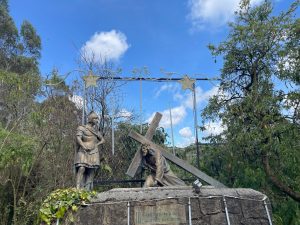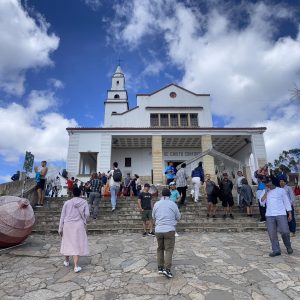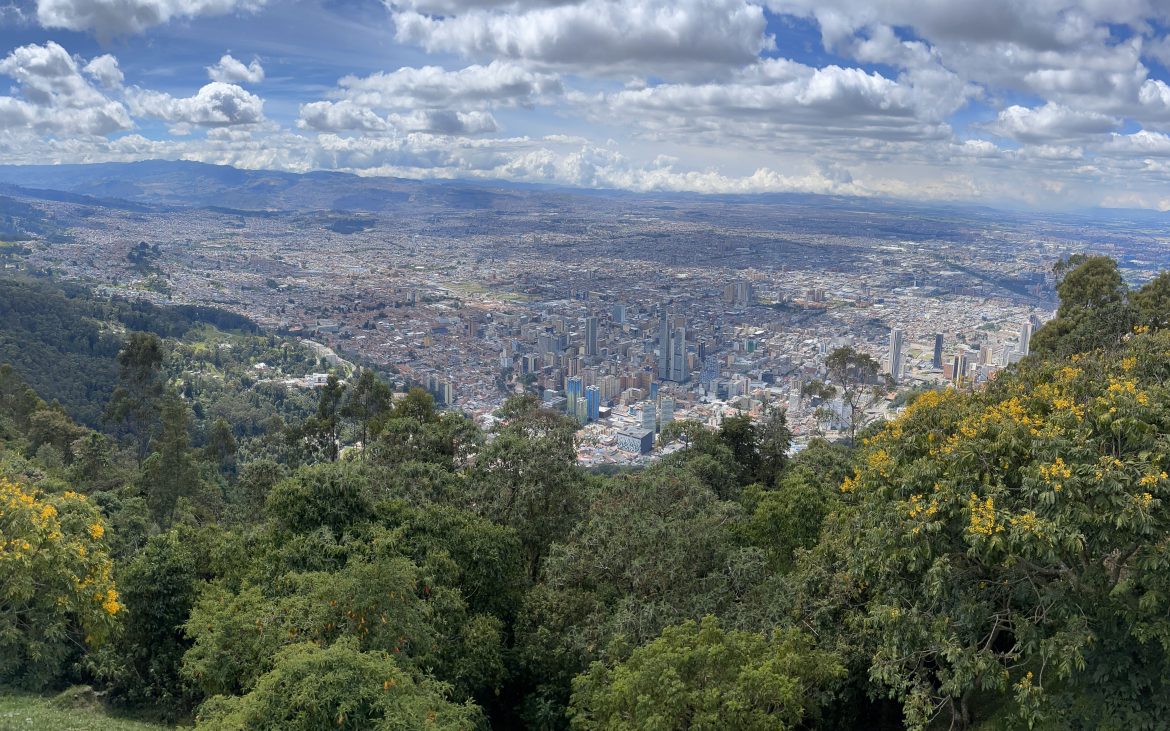Table of Contents
For those who love hiking and walking while on vacation, Bogota, situated 2640 meters (8,660 ft) above sea level, is an ideal city to explore on foot. The pleasant climate, characteristic of its high-altitude location, makes outdoor adventures comfortable and enjoyable.
Bogota was the first city we landed in Colombia, and we loved it and found it more appealing than Medellin, which is our second choice as a metropolitan city in Colombia.
Cerro de Monserrate is a towering hill, the highest point in the city, crowned by a cathedral at its summit. The moderately steep hike to the top is a rewarding experience, allowing you to indulge in physical activity and the awe-inspiring panoramic views of the city below. So, if you are in Bogota, this short hike is a must-do activity for your Bogota city visit.
Getting to the Base of the Hill
Getting to the base of the hill is easy as it is located in the center of Bogota. You can reach the base of the hiking trail via rideshare or TransMilenio (a bus rapid transit system providing transportation services in Bogota and its neighboring areas) or walk there if you are nearby.
Note: I advise against taking taxis off the streets in Colombia due to the prevalence of taxi scams. Instead, we consistently opted for the rideshare app Uber. In Colombia, traditional taxis and private cars are available on this app. On the occasions when we did take a cab off the street, we discovered that they tend to overcharge tourists, often charging three times more than Uber fares.
Price: Free to hike or buy a ticket to take the cable car or train in person or online
Difficulty Level: Easy-moderate. Like a stair climb.
Is the Trail Safe?
We felt very safe on the trail. We met happy local families with children, trail runners, and tourists of all ages while hiking. There were enough people on the trail to be festive but not crowded.
Even on quiet weekdays, park rangers check posts at the entrance and along the trail to contribute to a secure environment. However, those who do not feel safe going alone can have guided tour hikes available. But make sure you pick a guide from reputable platforms like Airbnb Experiences.
How Long is the Hike?
Our journey took around 3 to 4 hours (round trip), including the time we spent at the restaurant on the top and time to explore and take photographs. Ultimately, the duration of your ascent is not crucial; reaching the top is the accomplishment.
The hike is relatively straightforward; it is paved and with well-marked paths. You will find many people on the trail, but it does not make it congested.
Is the Hike Challenging?
A person with average fitness can easily do this 2.4-kilometer trail with a 1,968-ft elevation gain. The challenging aspects of this hike are the higher elevation and the stairs, but the steps are manageable and prevent excessive strain. Some may experience high-elevation discomfort.
If hiking isn’t your preference, you can use a funicular and cable car for quicker transportation to the summit, allowing everyone to enjoy the breathtaking views without the strenuous climb.
Note: You can view the complete route we took on Google Maps here and Garmin GPS Route map with hike statistics.
What the Hike Offers?
The hike unveils various experiences, from a stunning view of the capital and the diverse flora and fauna on the hill to handicrafts and traditional food stalls.
There are kiosks serving snacks and beverages along the trail, so you do no need to carry a lot of water and food supplies.
Upon reaching the summit, you will discover captivating gardens with exquisite flower arrangements and the Basilica Sanctuary of Monserrate, adorned with intriguing colonial sculptures. Notably, a statue of the fallen Lord of Monserrate depicts Jesus during his third fall on the way to Calvary—an esteemed and miraculous figure according to the Christian traditions. It is said that attempts to lower this statue to the city have been futile due to its high weight.
Adjacent to the sanctuary, a spacious plaza features handicrafts, souvenirs, and a cluster of restaurants, including two traditional century-old restaurants offering typical Colombian and international cuisine. Their decorated terraces with mountain and city views add to the charm. We had the best tomato soup, beverages, and a view from their terrace.
However, the best experience is the viewpoint, providing unrivaled Cerro de Guadalupe vistas, Bogota’s best views, and enchanting sunsets. As night falls, witnessing the capital illuminated would have been a spectacular sight. But we only stayed for a short time. Similarly, early or weekday mornings could offer a tranquil and mystic experience in a less crowded environment.
Some History: The Ancient Holy Site Leading to the Basilica
“Monserrate is more than a mere tourist attraction; it’s a sacred hill for the indigenous Muiscas, serving as a pilgrimage site long before the arrival of the Spanish.
The Muisca Civilization and the El Dorado Myth
The Muisca civilization thrived between 600 and 1600 CE, with some historians suggesting its origins could date back to as early as 1500 B.C.E. The early inhabitants primarily resided in modern-day Bogota and its surrounding valleys and mountains. They held mystical beliefs, venerating the sun and water.
The El Dorado myth originates from the Muisca people, who are renowned for their remarkable gold craftsmanship. The prospective leader would be adorned in gold dust during their ritual and positioned on a golden raft in a lake. Offering gold and emeralds to deities, particularly Suéá (sun god) and Bachué (water goddess), signified the leader’s ceremonial rise to power. Today, the golden raft can be observed at the Museum of Gold in Bogotá.
Historians generally agree that the Muisca civilization was as advanced as their contemporaries, the Inca, Aztec, and Mayan tribes. They were a thriving and flourishing society before the Spanish Inquisition in 1600. Their population dwindled from between 500,000 and 3,000,000 to just a few thousand in present-day Colombia.
The Basilica of the Fallen Lord Christ of Monserrate
On the sacred site of the Muisca inhabitants, the Spanish constructed a colonial-style church, “The Basilica of the Fallen Lord Christ of Monserrate,” which was completed in 1657. This basilica has been a pilgrimage destination ever since. The chapel was dedicated to the Fallen Lord Christ, whose statue stands next to the church. Numerous stories about the church and the miracles that occurred there have made this site a popular pilgrimage destination.

The Fallen Lord Christ of Monserrate
Pedro de Lugo Albarracín, the grandson of De Albarracín, crafted the Fallen Lord Christ statue. De Albarracín was a Spanish explorer who participated in the Spanish inquisition of the Muisca and Panche tribes. In 1536, he led the ships that sailed up the Magdalena River from the Caribbean coast, where he discovered high-quality salt. Pedro de Lugo dedicated his work to creating devotional images and sculptures of the Passion of Christ. This image of Christ, known as the Lord of Monserrate, is one of his famous works in Bogota.

Neo-Gothic style Church at the Summit
The original chapel was destroyed in the 1917 earthquake, and a new, expanded one was completed in 1925. The new church, built in a Neo-Gothic style, was constructed with the help of pilgrims, each of whom contributed at least one brick.
References on Colombian History and Culture
- “Juan de Albarracín.” Wikipedia, https://en.wikipedia.org/wiki/Juan_de_Albarrac%C3%ADn. Accessed 11 Feb. 2024.
- “Monserrate.” Wikipedia, https://en.wikipedia.org/wiki/Monserrate. Accessed 11 Feb. 2024.
- “The Muisca: Colombia’s Lost People.” Uncharted Colombia, https://www.unchartedcolombia.com/en/community/travel-stories/the-muisca-colombias-lost-people/. Accessed 13 Feb. 2024.
- “Muisca Civilization.” World History Encyclopedia, https://www.worldhistory.org/Muisca_Civilization/. Accessed 14 Feb. 2024.
- “Muisca.” Wikipedia, https://en.wikipedia.org/wiki/Muisca. Accessed 19 Feb. 2024.
- “Muisca Civilization.” World History Encyclopedia, https://www.worldhistory.org/Muisca_Civilization/. Accessed 19 Feb. 2024.
- “The Muisca: Colombia’s Lost People.” Uncharted Colombia, https://www.unchartedcolombia.com/en/community/travel-stories/the-muisca-colombias-lost-people/. Accessed 19 Feb. 2024.
- “Muisca Raft.” Wikipedia, https://en.wikipedia.org/wiki/Muisca_raft. Accessed 19 Feb. 2024.

